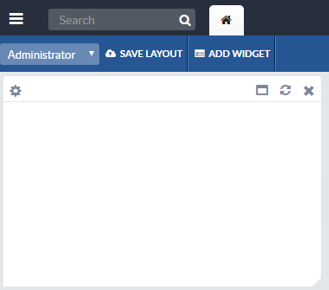Using Widgets
Add a Widget
To add a widget to a Dashboard, click the Add Widget button on the Dashboard’s Activity Bar. A blank widget will be added to the Dashboard. The blank widget has not yet been configured.

To see and access the widget’s Activity Bar, hover over the top of the
blank widget’s window. The widget’s Activity Bar consists of (left to
right): a Settings icon ![]() , a Title, a Maximize icon
, a Title, a Maximize icon ![]() , a Refresh icon
, a Refresh icon ![]() , and a Close Window icon
, and a Close Window icon ![]() .
.

Users with sufficient permissions can click the Save Layout button on the Dashboard’s Activity Bar to save the Dashboard’s new configuration as the Dashboard for the user group specified in the Dashboard Selector dropdown list. If the user of Personal Dashboards has been enabled, the user can click the Save Layout button to save the configuration as their new personal Dashboard.
To configure the widget for a certain purpose:
- Click the widget’s Settings
 icon. A Configuration window will appear.
icon. A Configuration window will appear. - Enter a title for the widget in the Configuration window’s Title field. This is the title the widget will display, so it is recommended that the user select a title that names the widget and indicates what type of widget it is, for example, "Product Repository Status Report".
- Select the desired type of widget in the Configuration window’s Type dropdown list. Configuration options applicable to the selected widget type will appear.
- Configure the widget as desired. For detailed instructions for configuring specific widgets, use the Online Help's search box or navigation menu to find the desired widget.
-
Click Apply to save the changes to the widget and close the Configuration window. Click Cancel to close the Configuration window without saving the changes.
-
If you want your Dashboard configuration to remain after you switch tabs or log out, click the Save Layout button on the Dashboard's Activity Bar, otherwise your Dashboard will revert to its last saved configuration.
Remove a Widget
To remove a widget from the Dashboard, click the Close Window icon
![]() on the widget’s upper right corner. The widget will be removed from the
Dashboard.
on the widget’s upper right corner. The widget will be removed from the
Dashboard.
Change the Size of a Widget
Widgets are displayed on a grid system – when they are repositioned or sized, their location or size will snap to the next grid line. A shaded background box indicates what their new position or size will be. Note that moving or resizing a widget may cause the other widgets to be rearranged to make room for it.
To change the size of a widget, move the cursor to any edge or corner of the widget. When the double headed arrow appears, click and drag the widget window to the desired size, then release the mouse button. Depending on the type of widget, the content of the widget will be distributed across the new space.
Click the Maximize icon ![]() to expand the widget to fill screen space.
to expand the widget to fill screen space.
Click the Restore icon ![]() to return the widget to the size it was before the widget size was
maximized.
to return the widget to the size it was before the widget size was
maximized.
Move a Widget
Widgets are displayed on a grid system – when they are repositioned or sized, their location or size will snap to the next gridline. A shaded background box indicates what their new position or size will be. Note that moving or resizing a widget may cause the other widgets to be rearranged to make room for it.
To move a widget, position the cursor on the widget’s Activity Bar. The cursor will change into a picture of a hand. Click and drag the widget to the desired position. Note that other widgets will change position to accommodate the new position of the widget.
Refresh a Widget
Note that the content of widgets do not auto-refresh. The user must refresh a widget to update the data it displays.
To refresh the contents of a widget, click the Refresh icon ![]() on the upper right of a widget’s Activity Bar.
on the upper right of a widget’s Activity Bar.
